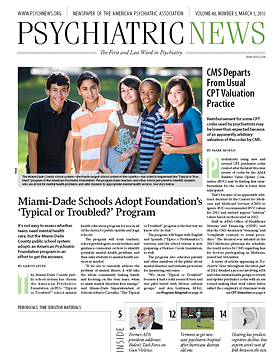Somatic symptom and related disorders—known previously in DSM-IV as somatoform disorders—brings together in one chapter disorders characterized by disproportionate thoughts, feelings, and behaviors related to somatic symptoms.
The chapter—the ninth in Section II of the new DSM-5,—eliminates several diagnoses (somatization disorder, hypochondriasis, pain disorder, and undifferentiated somatoform disorder), removes some redundancies and extraneous features in previous criteria, and more clearly delineates the separate diagnoses that make up this chapter.
But Joel Dimsdale, M.D., chair of the Somatic Symptom and Related Disorders Work Group, emphasized that the most important change overall in this set of disorders is removal of the centrality of medically unexplained symptoms. “That was a defining characteristic of these disorders in DSM-IV, but we believe it was unhelpful and promoted a mind-body dualism that is hard to justify,” he told Psychiatric News.
So, for instance, the diagnosis of somatization disorder in DSM-IV was based on a long and complex symptom count of medically unexplained symptoms. DSM-5 criteria eliminate that requirement and recognize that individuals who meet criteria for somatic symptom disorder—the new designation, marked by disproportionate thoughts, feelings, and behaviors related to somatic symptoms—may or may not have a medically diagnosed condition.
Hypochondriasis has been eliminated; most individuals who would previously have been diagnosed with hypochondriasis have significant somatic symptoms in addition to their high health anxiety and should receive a DSM-5 diagnosis of somatic symptom disorder. Those with high health anxiety without somatic symptoms should receive a diagnosis of illness anxiety disorder.
Criteria for factitious disorder in DSM-IV included variations for whether the falsified symptoms were psychological or medical in nature, a distinction that has been removed from DSM-5.
Criteria for conversion disorder have been modified to emphasize that the somatic symptoms are incompatible with recognized neurological or medical conditions.
“Psychological factors affecting other medical conditions” (PFAMC) formerly appeared in DSM-IV in a chapter called “Other Conditions That May Be a Focus of Clinical Attention.” It is now among the somatic symptom and related disorders, and the multiple variants of PFAMC described in DSM-IV have been removed.
“The heart of these disorders is a disproportionate and excessive response to somatic symptoms,” Dimsdale said. “We are talking about persistent symptoms lasting six months including thoughts, feelings, and behaviors that are disproportionate to somatic symptoms. Patients may catastrophize about fairly minor somatic symptoms, become very anxious and constantly scan for information about an illness, or avoid situations and behaviors they believe are related to illness.
“I treat many patients with psychiatric illness along with medical disorders,” he said. “Patients respond to medical illness in a variety of ways—some become depressed, some become anxious, some cope with stoicism. But a minority of patients do have their lives consumed by somatic symptoms.
“Our view is that suffering is authentic and that whether or not there is a medical explanation, we take patients’ suffering seriously,” Dimsdale said. ■
Audio clips of Dimsdale discussing somatic symptom disorder, the rationale behind the changes regarding somatic symptoms, and whether somatic symptom disorder will result in missing other medical problems can be accessed at
http://www.psychiatry.org/dsm5.
